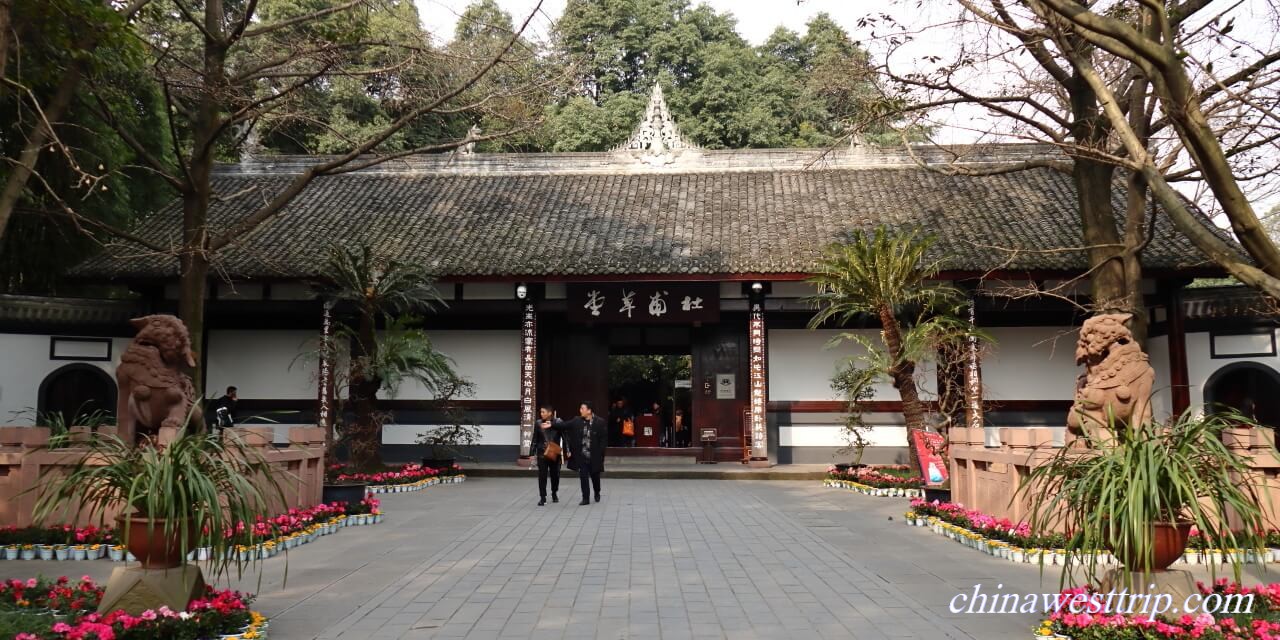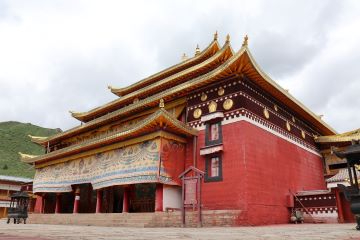Du Fu's Thatched Cottage
 Name in Chinese: 杜甫草堂 Dù Fǔ Cǎo Táng [du: fu: tsao tæŋ]
Name in Chinese: 杜甫草堂 Dù Fǔ Cǎo Táng [du: fu: tsao tæŋ]
Duration of Tour: One and a Half Hours
Location: No.37, Qinghua Road, Qingyang District, Chengdu, Sichuan Province
Highlights: Exploring Ancient Chinese Literature, Traditional Chinese Garden
Must-see Sightseeing Spots: the Front Gate, the Daxie Lobby, the Hall of Historical Poetry, Gongbu Shrine and the Thatched Cottage
Reputations: A National Key Historical and Cultural Relic Site under Protection, A National Four-star Scenic Area, One of China’s Top-class Museums, A Holy-land of Chinese Literature
Du Fu Thatched Cottage is one of the top five historical sites in Chengdu. It is devoted to Du Fu, a famous poet in the Tang Dynasty. Located in the western suburb of Chengdu, the cottage used to be the former residence of Du Fu.
A Biography of Du Fu
The classical Chinese poetry has been in existence for two thousand years. The epitome of poetry was in the Tang Dynasty(618-907). The most famous poet in the Tang Dyansty were Du Fu and Li Bai. Based on the judgement of some Western critics, Du Fu is the most representative figure. The nature, content, and sound of his poems have made him very appealing to the world.
Du Fu was born in Gongxian County, Henan Province in 721. He was also called as Du Zimei. He spent the greater part of his boyhood in Luoyang. In 746, he went to Chang’an, the capital of Tang, in an attempt to obtain an official post. However, he had only reached a minor post as he entered the age of fifty.
Du Fu lived at the turning point of the Tang Dyansty when the empire began to decline. In 755, An Lushan Rebellion broke out. It weakened the empire. The rebellion lasted from 756 to 763. Du Fu fled the capital, but was captured by the rebels. He escaped and went to Chengdu in 759. Du Fu stayed in Chengdu for 4 years, and composed over 240 poems in Chengdu. The great poet passed away in 770.
Chinese literary critics in the following dynasties referred to Du Fu as the poet-historian, the greatest poet in the whole Chinese history. He lived through the chaos and witnessed a typical political and social situation. The ordinary people were suffering from poverty and starvation, while the officials enjoyed a foolish luxurious life. Du Fu composed his poems to expose the injustice of the society, and express his dissatisfaction with the government and his great pity for those who lived in poverty.
Du Fu Thatched Cottage was built when the great poet decided to stay in Chengdu. After he left Chengdu for his hometown, his cottage was destroyed. In 907, Tang Empire was overthrown, and carved into over ten independent states. It is called the Five Dynasties and Ten States Period, which lasted from 907 to 979. During the period, Sichuan was occupied by the Former Shu State(907-925) and the Later Shu State(934-965). Wei Zhuang, a poet, used to be the prime minister of the Former Shu State. He loved Du Fu and his works. The prime minister built a memorial hall on the same site where Du Fu’s cottage was located. In the Song Dynasty, it was rebuilt. By the end of Ming Dynasty, the cottage was demolished due to the war between the government and the rebels. The present buildings could be dated back to Emperor Kangxi’s reign(1662---1722), the Qing Dynasty. Most part of the memorial complex were rebuilt in 1811, the sixteenth year of Emperor Jiaqing’s reign. The complex consists of six main buildings, namely, the Front Gate, the Daxie Lobby, the Hall of Historical Poetry, the Water Pavilion, Gongbu Shrine and the Thatched Cottage.
The Front Gate
There is a horizontal board on the top of the entrance gate. It is inscribed with two Chinese characters. It reads Cao Tang. Cao Tang mean thatched cottage. The inscription is in the handwriting of Yunli, a prince of the Qing Dynasty, the 17th son of Emperor Kangxi. A couplet hangs on both sides of the door. It reads that the cottage is near the west side of Wanli Bridge, and to the north of Baihuatan Pond. The couplet indicates the original location of the cottage.
The Daxie Lobby
Daxie means office where the officials in ancient time worked. Du Fu once got an official title as Zuoshiyi. His job was mainly to give a mild warning to the Tang emperors. However, Du Fu was not a skilled survivor in official circles. He gave up his post in the court. As the building was completed, it was named as Daxie to remind visitors of the short but excellent service which Du Fu offered to Tang government.
A bronze sculpture of Du Fu is placed in the center of the lobby. It was made by Qian Shaowu, a well-known artist from the Central Academy of Arts in Beijing. Du Fu remains in a kneeling position, holding a book in his hand. He looks slightly upwards. What does his posture suggest? Du Fu experienced the chaos caused by the rebellion. He was anxious to do something for his people who lived in poverty. However, his capacity to serve society was limited. Besides, he was far away from his hometown and his family. He could do nothing, but compose and chant his poems to express his unbearable loneliness and failure in officialdom.
The Hall of Historical Poetry
Another sculpture of Du Fu is placed in the hall. The couplet hanging on both sides of the hall reads that the thatched cottage lasts many generations, the poetry sage and his works remain well-known for a thousand centuries.
Gongbu Shrine
Gongbu was a title given to the officials who worked in the regional industry and construction administration. Du Fu was assigned as Gongbu by the local governor. The shrine is dedicated to Du Fu. The hall contains Du fu’s statue in the middle. His image is flanked with other two figures, namely Huang Tingjian(1045---1105) and Lu You(1125---1210). Both were celebrated poets in the Song Dynasty(960---1279), and occupied very important positions in Chinese literary history. Why did people place the two figures together with Du Fu in the shrine? Firstly, both Huang Tingjian and Lu You made great achievement in studying Du Fu’ works, they both loved his works much. Secondly, both of them once traveled to Sichuan, and enjoyed their stay in Sichuan as much as Du Fu did. Thirdly, Du Fu might have felt lonely without any companion. People placed the images together in the shrine so that they might have time to talk about their poetry works.
The Thatched Cottage
Located on the left of Gongbu Shrine, the straw-roofed cottage was built to remind visitors that Du Fu had a simple and peaceful life in his cottage. Nearby the cottage, there is a stone tablet. The tablet is engraved with two Chinese characters. It reads Cao Tang. It is in the handwriting of Yunli, the prince of Qing Dynasty, the 17th son of Emperor Kangxi.
Opening Hours:
8:00a.m.---6:00p.m.
Related Articles:
Chengdu Travel Guide
Author: Tina Luo
Update:
